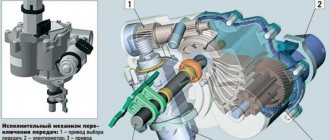For a considerable part of the population, a car has remained a luxury since the times of the USSR, which, if you buy, is obviously for a long time. Since the fall of the Iron Curtain, there have been legends about the notorious “German quality” (the Skoda brand has long been ingrained in people’s memory as a “cheap Volkswagen”) of vehicles. AvtoVAZ “gained fame” as a car, which greatly hinders its development. Even specialists from Renault and Nissan cannot regain lost trust, but with the release of a new model range, it is beginning to acquire a lighter shade.
Which is better: Skoda Rapid or Lada Vesta
We will find out which of them will win today’s “race” after a short time (depending on your reading speed). When comparing facts about the Lada West and the Skoda model, a funny fact emerged: the body types of the tested products of the automotive giants are significantly different. The Rapid is a liftback, the vesta can only be presented as a sedan and, more recently, as a station wagon. Taking into account that the competitors from VAZ & VAG (what consonant abbreviations) belong to the same class B+, we come to the general opinion that it is reasonable to compare the Lada Vesta with the Skoda Rapid. At first glance, you can find out about the choice of the majority of Russians by looking at the number of Lada Vesta sales. Afterwards, compare the number of Skoda copies sold and the trick. Let's take a closer look at what merits each car is chosen for. Of course, we won’t keep silent about the “cons” of each model discussed today.
On the circle
We have praised the Lada Vesta many times for its driver's chassis, but even it turned out to be powerless against the Rapid. And it’s not just about the advantages of the engine and gearbox. Skoda has vast experience of Volkswagen engineers who regularly delight the world with their charged versions. So, even the standard Rapid with a European ground clearance of 136 mm turned out to be much more interesting and clearer in aerobatics than the much taller Vesta.
On the lap, the Lada Vesta SV was unable to oppose anything to the Rapid.
On the verge of sliding, Rapid feels much more confident. The stabilization system helps steer the car into a turn and does not limit power during acceleration. Well, and of course, a more pleasant steering wheel and grippy seats. It’s no coincidence that Rapid’s closest relative, the VW Polo sedan, has a slightly warmed-up GT version. Moreover, it was obtained only with stickers on the hood and larger wheels. The chassis is set up perfectly.
3:0 in favor of Skoda Rapid.
Skoda Rapid or Lada Vesta? What's better - salon
“our” car or a foreign one? From the inside, the VAZ looks more modern: an instrument panel with deep “wells”, an interesting torpedo shape, front seats with good lateral support. There is enough space in the back row even with a driver and a passenger sitting in front with long limbs; getting into the cabin through the rear doors is not a problem. This should appeal to young users (approximately under 40 years old). We cannot fail to mention the fairly good viewing angle. Poor visibility (especially when reversing) forces consumers to pay for the additional installation of parking sensors with other rear view cameras. Of course, if it is not provided for in the package. Sales people are very pleased with the growing profits for installing additional add-ons. The air conditioning system for vesta, which is necessary for many, is available in any configuration, with the exception of the basic one (vesta classic). Performs assigned duties well, even on a summer day there is a risk of freezing. The sound insulation of the fret is made a little better, thanks to the use of felt instead of plastic fender liners. There was also a “fly in the ointment”:
the brake and accelerator pedals were placed too close; design miscalculation in the placement of the driver's armrest; The quality of the plastic is poor, the “crickets” will not take long to appear again. It’s surprising that even today the manufacturer of the Russian model is not too lazy to remind you that there is a cup holder in the cabin!
The interior of the competitor from Deutschland looks quite “German”, has almost standard ergonomics, better plastic quality, and the fit of parts is also at a higher level - in a word, classic. The seats have unobtrusive lateral support, but remain comfortable. Air conditioning is installed from the factory only on the Ambition package; it can be installed on the Active and Entry packages for additional money. Style cannot be equipped with an air conditioning system at all - it has climate control. It turns out that the target audience of the Rapid and the Lada Vesta are very different people. Even the almost perfect Skoda is not without its drawbacks:
modest size of the driver's and front right door openings; the armrest prevents you from using the handbrake; gas pedal travel is only 5 cm; the large angle of inclination of the rear window upsets tall passengers in the rear row (they did not complain about the lack of space); there is a design flaw in the location of the front fog lights, leading to frequent glass replacement; wide rear pillars reduce visibility; The fuel tank flap cannot be closed (there is no locking mechanism
What to buy in the end?
So which is which is better? Skoda Rapid or Lada Vesta? The comparison showed that both models are as close as possible to each other. Here, personal perception of the body, specific capabilities, impressions and wishes will play an important role. Each of the models has strengths and weaknesses that can be a serious problem in certain situations. For example, the Lada Vesta, due to the characteristics of the body, makes it possible to transport less cargo in the luggage compartment than a liftback. If a car is purchased for the constant transportation of cargo, then the choice is obvious.
On the other hand, Skoda is suitable for those who value a world-famous brand. The Russian model, although not so well known, will allow you to save a little. Even if not in its “pure” form, you can use the difference to buy a package you like with comfortable functions. Both versions are well equipped and the amount of equipment corresponds to the stated price.
The choice of equipment is not the only difficulty. The buyer will have to decide on a suitable engine, of which there are plenty. Most of the engine range is occupied by naturally aspirated engines, but Skoda also received the only turbocharged one. For connoisseurs of speed, Lada has prepared a special “charged” sedan with the Sport index.
Skoda will be chosen by connoisseurs of calm design and classic performance. The Russian model is made in a corporate style with an abundance of X-shaped stampings and elements. Designer finds are more to the liking of the younger generation, while the older generation values reliability and confidence in high quality more. Low consumption and compact dimensions are ideal companions for urban use, but the models also show their advantage on the highway. It is better to avoid trips to nature, since the ground clearance will not be enough to overcome difficult obstacles - you can lose your bumper or damage the suspension.
The advantages of Vesta include the alternative body. In addition to the sedan, the manufacturer offers a station wagon. The liftback tries to combine the modesty of a sedan and the practicality of a station wagon. In addition, the sedan is sold in a sports and bi-fuel version, which the Czechs did not allow themselves.
Comparison of bodies and wheelbases
According to the characteristics indicated in the sales sources of new Lada vesta cars and a competitor from the Skoda brand, the confrontation between Russian cars (Skoda is assembled in our country) is gaining momentum. The Rapid is produced only in a liftback body, the Vesta can be produced in a station wagon and a sedan.
The Czech product beats the domestic one only in length (4483 mm versus 4410 mm). Otherwise, the Lada turns out to be a favorite: width (1764 mm -1706 mm), height (1497 mm - 1474 mm), wheelbase (2635 mm - 2602 mm). The VAZ vesta model has a smaller thickness of the “skin” to reduce weight.
Comfort and safety systems
Both the sedan and the liftback are well equipped. The list includes numerous security systems that are found in high-end models. It is noteworthy that before the appearance of the Russian sedan, many experts were skeptical about quality. However, the engineers managed to dispel the boring stereotype about the low quality of elements and assembly. Practice proves that breakdowns of modern Vesta are a rare occurrence. Manufacturers did not skimp on security systems either. Even in a minimal design, they are enough to minimize the consequences in the event of an accident. Comfort systems are brighter and more noticeable in the highest trim levels, which is understandable given the significant increase in price.
Drive and gearbox
Today's competitors are exclusively front-wheel drive and can be equipped with manual or automatic transmission. There are no complaints about manual variable gearboxes (the exception is the “inherited” howl of the Russian-made VAZ manual transmission on Lada). If “mechanics” is not given to you, with all confidence, buy only a “Czech”. The Vesta's robotic gearbox cannot be compared with the DSG type transmission offered by VAG specifically for the 1.4 liter turbo engine. If the client prefers a “classic” gearbox, Skoda has provided this option by offering a 5-speed torque converter. Gears change quickly, so you don’t have to ride behind everyone else in traffic.
↑ Salon
The interior space of a 5 seater Lada Vesta, Skoda Rapid or Skoda Octavia is a complete continuation of what can be seen outside. The Vesta salon will certainly impress every car enthusiast who is familiar with AvtoVAZ’s previous products, because in this case the domestic company managed to make a truly qualitative leap.
When reviewing the Lada's interior, it is worth noting a convenient dashboard with impressive gauge wells, a high-quality three-spoke steering wheel, a modern center console with a large display, as well as comfortable seats with impressive lateral support. The interior space of the sedan has impressive ergonomics, which no VAZ model could boast of.
It is important that despite the Vesta’s compactness, the car’s interior is quite spacious, and the stated number of seats, equal to 5, is completely true. There is plenty of space here, both for front seat passengers and for those in the second row. The rear seats have three head restraints for greater comfort.
The Skoda Rapid salon is the same Czech-German neatness, pedantry, and attention to detail. The highest ergonomics of the driver's seat, perfect readability of the dashboard, mega-comfortable seats, a first-class air conditioning system - all this turns a trip in a Czech liftback into a real pleasure.
Whose appearance is better?
Vesta looks more aggressive in appearance (look at the front - you will notice the massive radiator grille), with emphasized “muscles” due to the presence of side X-stampings. The design of the rear lights goes well with the glitter on the trunk lid and the large bumper.
Skoda Rapid is trying to imitate its “big sister” - the Octavia, so much so that an ignorant person would confuse it (the A7 body is in pre-Restyle, which caused the Octavia-vods to “burn” rather sourly). Correct shapes, classic outlines in the Volkswagen style, calm design give a certain solidity in appearance. The type of car instantly becomes noticeable - beauty lies in simplicity. The almost square lights at the stern of the rapid only confirm these arguments.
Equipment and cost
Manufacturers have been building their reputation for reliability for decades, and Skoda seems to have a slight edge when all models are taken into account. These are official data, while users rate the reliability of Lada with an average rating of 3.8, and Skoda models - 4.4 out of 5. In addition, drivers of cars with the same engine as the Russian car rate it an average of 3 ,0 out of 5, exactly the same as the others. The price of the Lada Vesta on sale starts from $11,200 for standard equipment, while the price for the most affordable Skoda Rapid is $15,100.
The Rapid is quite comfortable to sit on. The front seats are generally comfortable, with lateral support to keep you in place and plenty of cushion to support your thighs. Their lumbar region appears a little empty. The rear seats are firm and excellently supportive, offering adequate thigh support, generous legroom and a good amount of knee room. In Lada Vesta you will not get the same feeling of space.
Car trunk
I feel your patience is coming to an end, because not a word was said about the capacity of the Rapid's trunk. The luggage compartment can accommodate as much as 530 liters. versus 480 hp available to users of the Lada Vesta sedan. We do not take the “Okay” station wagon into comparison due to the lack of similar performance in the presented car from VAG (Spaceback can be compared with the SW/SV cross station wagon, which will not happen now).
Why did it happen so?
Perhaps the automatic requests do not belong to you, but to another user accessing the network from the same IP address as you. You need to enter the characters into the form once, after which we will remember you and be able to distinguish you from other users exiting from this IP. In this case, the page with the captcha will not bother you for quite a long time.
You may have add-ons installed in your browser that can make automatic search requests. In this case, we recommend that you disable them.
It is also possible that your computer is infected with a virus program that is using it to collect information. Maybe you should check your system for viruses.
If you have any problems or would like our support team, please use the feedback form.
Don't be surprised that one of these cars looks like a taxi, while the other looks like a tuning project. In fact, they have more in common than meets the eye. Both Lada Vesta Sport and Skoda Rapid with a turbo engine cost about a million and can claim to be a driver's car. Lada, if only because it is a Sport version with all that it implies, and Skoda is an ordinary family car with a slightly unusual engine. The Volkswagen supercharged 1.4 is very fast for its class, so the dynamics of this “Rapid” make it quite a city lighter.
But does everything else match this engine? And will the more powerful Lada keep up with the nimble Skoda? Who is faster on the straight and who is the king of corners? What if you forget about the numbers and focus on the sensations? We went to the ADM Raceway in Myachkovo to find answers to these questions and will describe our findings in detail in the upcoming material. In the meantime, we offer a review video about these two cars, in which we share some facts, thoughts and impressions. Ask your questions in the comments, speak out in favor of your favorite and wait for the comparison test - it promises to be action-packed!
Chassis
Ground clearance (178 - 170 mm) - +8 mm in favor of the Volga car. There are no innovations at the front - only traditional MacPherson struts. A semi-independent beam is quite reasonably located at the rear (surprisingly, even in the configuration for a “supercharged” engine, an independent multi-link is not offered). “Czech” has a minimum of 14 wheels, the Lada is shod with 15 wheels.
Thanks to the suspension tuners, the Rapid seems more collected, but cannot boast of ride comfort in most of the Russian Federation; sometimes shock absorber breakdowns occur in the product of the Czech brand. Vesta steers a little worse, although on washboard-type roads it’s more pleasant to be inside its cabin.
We sit in the front
Skoda Rapid - very comfortable seats, steering wheel, everything is in place, at hand, the instruments do not strain the eyes. Disadvantage: the glove compartment is small.
Lada Vesta SV
Experts here also gave points to the Skoda Rapid - it is comfortable for the driver and smells nicer. (see video for details).
4:0 in favor of Skoda Rapid.
Engine performance and fuel consumption
Let's look carefully: all “metal hearts” are powered exclusively by AI-95 gasoline and have 4 cylinders. The range of Skoda Rapid engines is slightly wider: 3 versus 2 for the Vesta. The initial 1.6-liter power unit is a naturally-aspirated 16-valve engine with a power of 90 hp/4250 rpm, torque is 155 Nm/3800 rpm, a maximum speed of 185 km/h, acceleration to 100 will occur in 11.4 seconds. The second engine is similar to the first, but produces 110 hp. at 5800 rpm, the torque remained the same. The time before the first hundred became just over 10 seconds, and the “maximum speed” increased to 195 km/h. Naturally aspirated engines consume up to 5 l/100 km on the highway and up to 8 in the city. The third engine - 1.4TSI with a power of 125 horses at 5000 rpm has a torque of 200 nm in the range of 1400-4000 rpm. Acceleration to the usual 100 km/h will be only 9 seconds and will please you with good consumption (7 liters in the city and 4.3 liters on the highway).
The VAZ can be equipped with 1.6 engines with a power of 106 horsepower, a torque of 148 nm at 4200 rpm, and a 1.8 liter with a return of 122 hp/170 nm at 3750 rpm. The disappointment will come due to the slightly increased consumption: the smaller unit consumes 6.2 liters. on the highway and 10.2 liters. in the city. The more “angry” one devours gasoline more readily - 6.7 and 10 liters, unlike its smaller brother.
Traffic light start
Given the formal similarity in engine power, Skoda promises a fundamentally different level of dynamics, higher than that of the Vesta SV. How such a convincing difference was achieved with similar dimensions and power is a mystery, but that’s what independent independent tests exist for.
Test Skoda Rapid - Lada Vesta SV. We are preparing to start from a standing start.
In addition to the turbo engine, Skoda has the famous 7-speed robotic gearbox with two dry clutches. I can’t count how many drivers have encountered its not at all cheap repairs even with low mileages. Now Skoda has extended the warranty on the gearbox to 4 years and 120 thousand km, so there is hope that in a light car and with a power of 125 hp. the robot will serve, because it is also used on heavier Octavias and Superbachs, including those with 150-horsepower 1.4T engines and even 1.8 engines, from which 180 horses are removed.
We did not measure the acceleration time of our rivals with a stopwatch, but visually, with a parallel start, the difference was not so great. The Lada Vesta SV held on well (see the video for details of acceleration from a standstill).
Plunging headlong into the depths of on-board electronics, we were never able to find the “launch control” function. And without it, the electronics, even with ESP turned off, does not allow the turbo engine to reach power mode when starting with two pedals. As a result, the first second of starting from a standstill, the Skoda Rapid is in thought, the actuators smoothly close the clutches, and the engine tries to digest the turbo pause. At this time, Vesta SV, under the control of an experienced driver, takes the lead with a slight slip. But as soon as the Rapid engine spins up to at least 1500 rpm, the driver is pressed into the seat and the Skoda Rapid convincingly proves the superiority of modern technologies.
Skoda Rapid.
The shorter DSG gears of the Rapid School turn out faster, and the shifts are completely instantaneous. So by 50 km/h the Rapid compensates for an uncertain start, and by 100 km/h it outstrips the Vesta SV by more than a body. With further acceleration, the dynamics are maintained. Skoda literally rushes forward, questioning the formal similarity of power. In addition, we must not forget about the availability of chip tuning for the Skoda engine, but then it will simply turn into a rocket. But if you put the Rapid with a 110-horsepower 1.6 engine against the Vesta 1.8, then in terms of dynamics it will have parity with the Lada SV. Although Skoda is still ahead in terms of maximum speed.
Skoda leads 2:0
Guarantee of AvtoVAZ and a competitor in the form of Rapid
For detailed information, see the websites or car dealerships of AvtoVAZ and Skoda. Let me highlight the main points:
Both concerns provide a warranty period of 3 years or 100 thousand km, subject to timely maintenance at the dealer. Skoda promises to preserve the body from through holes appearing for a couple of years longer and provides a replacement vehicle for 5 days or less if prompt repair of yours is impossible.











